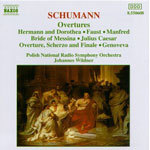
Schumann: Overtures (Incl. Overture, Scherzo and Finale, Op. 52 & Manfred, Op. 115)
 $25.00
Low Stock
add to cart
$25.00
Low Stock
add to cart
ROBERT SCHUMANN
Schumann: Overtures (Incl. Overture, Scherzo and Finale, Op. 52 & Manfred, Op. 115)
Polish National Radio Symphony Orchestra / Johannes Wildner, conductor
[ Naxos / CD ]
Release Date: Saturday 1 May 2004
Should this item be out of stock at the time of your order, we would expect to be able to supply it to you within 4 - 7 business days.
"Has anyone ever put these pieces together before? It's a good idea, sparing one the need of picking them up as fillers which can be expensive." - Fanfare
Wildner leads spirited performances ... produce a rich, luscious tone... uncommon repertoire at so low a price, this merits a recommendation, especially with such excellent (anonymous) program notes. - Leslie Gerber
- Classic Pulse - April 1995
"For Schumann's admirers the bargain disc is a must"
- Nottingham Evening Post
"Has anyone ever put these pieces together before? It's a good idea, sparing one the need of picking them up as fillers which can be expensive."
- Fanfare
Robert Schumann must seem in many ways typical of the age in which he lived, combining a number of the principal characteristics of Romanticism in his music and in his life. Born in Zwickau in 1810, the son of a book seller, publisher and writer, he showed an early interest in literature and later made a name for himself as a writer and editor of the Neue Zeitschrift für Musik, a journal launched in 1834. After a period at university to satisfy the ambitions of his widowed mother, but still showing the wide interests of a dilettante, Schumann was able to turn more fully to music under the tuition of Friedrich Wieck, a famous teacher, whose energies had been largely directed towards the training of his beloved daughter Clara, a pianist of prodigious early talent.
Schumann's own ambitions as a pianist were to be frustrated by a weakness of the fingers, the result, it is supposed, of mercury treatment for syphilis, which he perhaps had contracted from a servant-girl in Wieck's employment. Nevertheless he wrote a great deal of music for the piano during the 1830s, much of it in the form of shorter genre pieces, often enough with some extra-musical, literary or autobiographical association. The end of the decade brought a prolonged quarrel with Wieck, who did his utmost, through the courts, to prevent his daughter from marrying Schumann, bringing in support evidence of the latter's allegedly dissolute way of life. He might have considered, too, a certain mental instability, perhaps in part inherited, which brought periods of intense depression.
In 1840 Schumann and Clara married, with the permission of the court. The year brought the composition of a large number of songs and was followed by a period during which Clara encouraged her husband to tackle larger forms of orchestral music, while both of them had to make adjustments in their own lives to accommodate their differing professional requirements and the birth of children. A relatively short period in Leipzig was followed, in 1844, by residence in Dresden, where Wagner was now installed at the Court Theatre, his conversation causing Schumann to retire early to bed with a headache in 1850 the couple moved to Düsseldorf, where Schumann had been appointed director of music, a position the demands of which he was unable to meet, a fact that contributed to his suicidal depression and final break-down in 1854, leading to his death in the asylum at Endenich two years later Schumann completed his first symphony early in 1841 and it was performed on 31st March that year by the Leipzig Gewandhaus Orchestra, conducted by Mendelssohn In April he set to work on an Overture, intended as part of an orchestral suite, to which he added a Scherzo and a Finale, to be performed in Leipzig on 6th December. The Finale was later revised by the composer. The Overture opens with a brief introduction, marked Andante con moto, based on a brief motif of dramatic implication. An Allegro follows, with an initial theme that might well have sounded familiar to Mendelssohn, although Schumann never had quite the lightness of touch of that composer. The Scherzo and its Trio are scored more heavily than might have been expected, the woodwind assuming some prominence in the latter section, before the insistent rhythm of the Scherzo reasserts itself. The Trio makes a brief re-appearance before the final bars, in which the opening rhythm is recalled. The Finale has an imposing fugal opening, in a movement that seems to justify the composer's own reference to the work as a symphonette. There is an imposing cheerfulness about the music and a coherence of structure that enables it, as Schumann intended, to stand on its own, if this were to be required.
Tracks:
Overture, Scherzo and Finale, Op. 52
Genoveva, Op. 81
Bride of Messina, Op. 100
Julius Caesar, Op. 128
Hermann and Dorothea, Op. 136
Faust
Manfred, Op. 115



